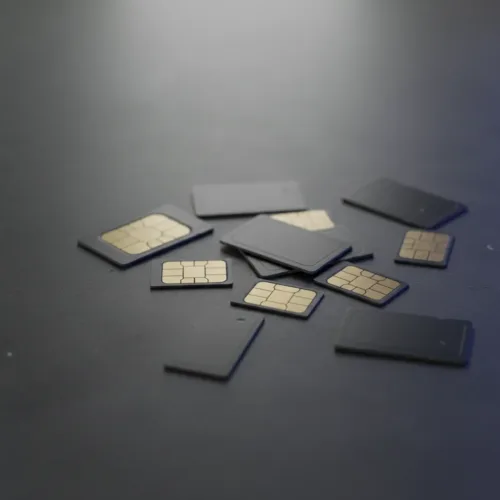
What is eSIM? Everything You Need to Know
November 11, 2025
eSIM QR Code: How to Scan, Install, and Fix Common Problems
November 19, 2025Staying connected is now a basic need. We use our phones to work, to travel, and to stay close to the people we love.
For many years, the only option was a physical SIM card. Today, we also have eSIM, a digital version that lives inside your phone. Both can connect you to the mobile network, but they do it in different ways.
Quick Version: eSIM vs Physical SIM in One Look
If you just need the idea fast:
Physical SIM = small plastic card you put in your phone.
eSIM = digital SIM built into your phone, no card needed.
If your phone supports it, eSIM is usually easier for travel and switching plans.
If you have an older phone or stay with one local carrier, physical SIM is still fine.
If you want to know more about what an eSIM is.
And now, let’s go a bit deeper.
What Is a Physical SIM Card?
A physical SIM is the small plastic chip that your mobile company gives you.
It has a metal part on one side and usually the logo of the company on the other side. You slide it into a small tray on your phone. Once it is inside, your phone connects to the network and you can call, text, and use mobile data.
Physical SIM basics:
You must visit a shop or order a card.
You insert it into the SIM tray on your phone.
To change your number or carrier, you usually swap the card.
Most people learned mobile phones with physical SIM cards, so they still feel safe and familiar.
What Is an eSIM and How to use it?
An eSIM (embedded SIM) is a digital SIM that is built inside your phone. There is no plastic card.
Instead, your mobile company or eSIM provider sends you eSIM details, often as a QR code or through an app. When you scan or install it, your phone saves a SIM profile in its memory. That profile acts like a normal SIM, but everything is digital.
eSIM basics:
No physical card to insert or remove.
You activate it by scanning a QR code or using an app.
Many phones let you store several eSIM profiles and switch between them in the settings.
In short: eSIM does the same job as a physical SIM, but without the plastic.
eSIM vs Physical SIM: Key Differences at a Glance
| Aspect | eSIM | Physical SIM |
|---|---|---|
| What it is | Digital SIM inside the phone. No card. | Plastic card you insert into the phone. |
| Setup | Activate with a QR code or app, usually in minutes. | Buy a card, insert it, maybe restart the phone. |
| Device support | Works only on newer phones that support eSIM. | Works on almost all phones, old and new. |
| Travel | You can buy before you fly and land with data ready. | Often need to find a shop after arrival. |
| Switching plans | Change plans in settings, no card swap. | Must take out the SIM and put a new one. |
| Risk of loss | Cannot lose a card, but depends on your phone. | Card can be lost, bent, or stolen. |
| Best for | People with modern phones who travel or switch plans often. | People with older phones or those who stay with one local network. |
If you understand this table, you already know the main picture of esim vs physical sim.
Pros and Cons of Physical SIM
Pros of Physical SIM
Works on almost any phone
Even very old phones support a physical SIM.Easy to understand
You can see and touch it. Many non-technical users feel more comfortable with a real card.Simple for local use
If you stay in one country with one carrier, a physical SIM can work for years without change.
Cons of Physical SIM
You must manage a small card
It can get lost, bent, or broken. Swapping between SIMs can also be annoying.Less flexible when traveling
After landing in a new country, you may need to find a shop, wait in line, and buy a new SIM.SIM tray can wear out
If you swap cards often, the SIM tray and pin hole can get loose or damaged over time.

eSIM vs Physical SIM: These scattered physical SIM cards hint at a past era, as the world transitions towards the seamless, digital convenience of eSIM technology.
Pros and Cons of eSIM
Now let’s see what eSIM adds on top.
Pros of eSIM
No plastic card
Nothing to lose, nothing to break, nothing to insert. Everything is digital.Fast activation
You can often buy an eSIM online and activate it in minutes, sometimes even while you are still at home.
Check this simple guide on how to activate eSIM on iPhone or Android.Multiple plans on one phone
Many phones allow several eSIM profiles plus a physical SIM. This is great if you switch between work and personal numbers, or between different countries.Great for travelers
You can land in a new country and already have data. No more running around the airport searching for a kiosk.
Cons of eSIM
Not all phones support it
You need a relatively new phone model that is eSIM-compatible.Moving between phones can be less obvious
With a physical SIM, you just move the card. With eSIM, you often need to deactivate it on one device and activate it on another, sometimes with help from the carrier.You depend fully on the phone
If the phone breaks and you don’t have backup options, reconnecting can take a bit of time.
eSIM vs Physical SIM for International Travel
For travel, the difference between esim vs physical sim becomes very clear.
When eSIM is Better for Travel
Short trips (3–14 days)
You can buy an eSIM just for data, use it during your trip, and then delete or turn it off when you return.Frequent travelers
If you often move between countries, eSIM lets you keep many plans and switch without opening your SIM tray.Late-night or remote arrivals
You don’t need to rely on shops being open. As long as you have Wi-Fi once, you can activate.
When Physical SIM Still Works Well
Long stays (several months or years)
A local physical SIM from a big carrier can sometimes be cheaper for long contracts.Small towns or rural areas
In some places, physical SIMs are still easier to find and manage than eSIM options.No eSIM support on your phone
If your device does not support eSIM, then physical SIM is the only choice.Using Both: eSIM and Physical SIM at the Same Time
Many modern phones can use dual SIM: for example, one eSIM + one physical SIM.
This can be very useful:
Keep your home country number on the physical SIM for calls and messages.
Use an eSIM for cheap data in the country you are visiting.
Switch which one is used for mobile data inside the phone settings.
In this way, esim vs physical sim is not always “one or the other.” Often, the best setup is both together.
Does My Phone Support eSIM? (Quick Check)
Check our list of the compatible eSIM devices, to see if your phone supports it.
To know if you can use an eSIM, you must check two things:
Phone model – Many newer iPhone, Samsung, Google Pixel, and other flagship models support eSIM.
Phone settings – You can usually go to:
Settings → Mobile / Cellular → Add eSIM
or Settings → Connections → SIM manager → Add eSIM
If you see an option like “Add eSIM” or “Add mobile plan”, there is a good chance your device supports it. If you do not see it, your phone may only work with physical SIM cards.
Security: eSIM vs Physical SIM
Both eSIM and physical SIM are designed to be safe, but they work a bit differently in practice.
Physical SIM Security
Someone can take the SIM card out of your phone and put it into another device.
If your phone is stolen and you do not block the SIM quickly, the thief may use your number.
eSIM Security
There is no card to remove, so it is harder for someone to physically steal your SIM.
Changes (like moving eSIM to another phone) sometimes require extra steps with your carrier or account, which adds a layer of protection.
Step-by-Step: How to Move from Physical SIM to eSIM
Heres a detailed version of this section, on how to change from SIM to eSIM.
If your phone and carrier support it, switching can be quite simple. The exact steps depend on your provider, but the general idea is:
Check eSIM support
Confirm that both your phone and your mobile company support eSIM.Ask your carrier for an eSIM
This can be in-store, on their website, or in their app.Get your QR code or activation details
They send you a QR code or give you a way to install the eSIM profile.Open your phone settings
Go to the mobile / cellular section and choose “Add eSIM” or similar.Scan and activate
Scan the QR code or follow the instructions. Wait for the phone to show signal.Test calls and data
Make sure everything works. When you are sure, you can remove or turn off your old physical SIM if you want.
Take it slow, and keep your physical SIM safe until you are 100% sure the eSIM is working.
Final Thoughts: Choosing Between eSIM and Physical SIM
In the end, esim vs physical sim is not about which one is perfect. It is about which one fits your life right now.
If you have a new phone, travel more, and like doing things online, eSIM gives you flexibility and comfort.
If you use an older phone, stay with one local network, and like to visit shops, a physical SIM is still a solid choice.
And if your phone allows it, using both together can give you the best of each world.
The best journeys usually start before you leave home — when your phone is ready, your connection is stable, and you feel free to move without worrying about signal or cards. Choose the option that supports that feeling, and you will already be one step ahead.
FAQ: eSIM vs Physical SIM Questions
1. Is eSIM more secure than a physical SIM?
Both can be secure if you act fast when a phone is lost. eSIM is harder to remove physically, but you still need strong passwords and to contact your carrier quickly in any problem.
2. Can I use eSIM and physical SIM at the same time?
On many modern phones, yes. You can have one eSIM and one physical SIM active together and choose which one uses data or makes calls.
3. Does eSIM work without internet?
You need internet (Wi-Fi or mobile data) to download and activate the eSIM profile. After that, it works like a normal SIM and connects to the network directly.
4. What happens if I change phones?
With a physical SIM, you move the card. With eSIM, you may need to remove it from the old device and re-activate it on the new one, sometimes with help from your carrier.
5. Will physical SIM cards disappear soon?
Physical SIMs are still widely used, especially in many countries and with cheaper phones. eSIM is growing fast, but both will probably exist together for some years.

